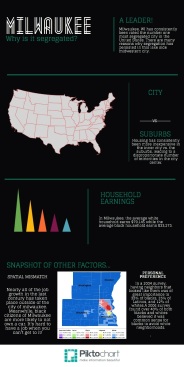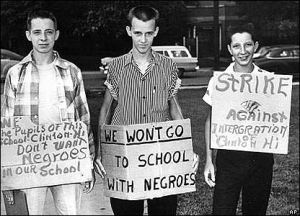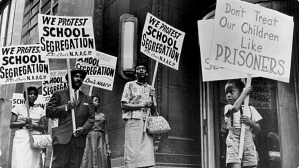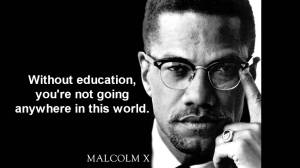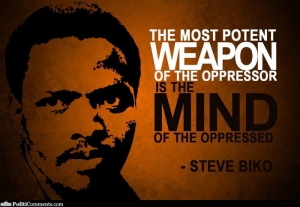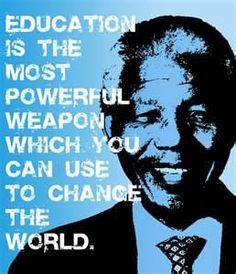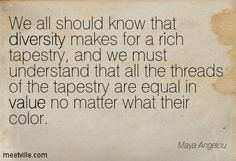Segregation is a complex topic. Here are some resources to help students(and yourself) digest the topic of segregation in classroom.
1. “Race Matters In Milwaukee: The Causes of Milwaukee Segregation.” The Milwaukee Drum. Web. http://themilwaukeedrum.com/2010/02/01/race-matters-in-milwaukee-the-causes-of-milwaukees-segregation/
This article provides a good overview on the causes of segregation in Milwaukee. It does a good job of providing text, as well as graphics, for students to digest as they begin to understand why segregation occurs. This article talks about aspects like income disparities, among others, as the causes of segregation in Milwaukee.
This text is very complex overall. It is set at an 11th grade reading level, or above, according to storytoolz.com. While this would be appropriate for high schoolers, lower level readers would need modifications to be done. This text has many qualitative measures that are complex as well. While the language used in this text is largely explicit, there are some times that the reader has to understand a more complex meaning. In addition the vocabulary is fairly contemporary and is not overly academic. The sentences are simple and compound with some complex structures, making the language in this text moderately complex. This text does have very complex knowledge demands, however. This text relies on moderate levels of discipline-specific knowledge, which gives this text a rating of very complex for knowledge demands.
This would be a great article to use to give students a good overview on segregation as it pertains to Milwaukee. The combination of text and graphics makes it interesting and easier to understand for higher level readers.
This would be a great introduction article. A great strategy to help students front load information and active their schema prior to reading the article would be to ask them the question, “Why does segregation exist in Milwaukee?” Have them do a “Think, Pair, Share”. They think about the question, write down their response, pair up with somebody and then the pair shares their answers with the class. Then, the class can read the article and revist the question. As you go through the article, I would suggest helping students uncover the bigger topics and point out things that you are going to go further into.
2.X, Malcolm, and Alex Haley. The Autobiography of Malcolm X. New York: One World/Ballantine, 1992. Print.
While learning about segregation it is important for students, especially urban students, to understand that there were many people that fought for equal rights. One of these people is Malcolm X. I think that his autobiography is really good to introduce students to because Malcolm X often is perceived in a negative light, but in reality he did a lot for African Americans in regards to pushing for equality.
The great thing about this autobiography is that it is at an 8th grade reading level, which makes it accessible to many readers who would be learning about this topic. While it is a long book, if you pull excerpts from his autobiography it is much more manageable to study. He uses fairly short sentences, averaging about 15 words per sentence. Qualitatively, however, this text is complex. This text uses very complex language features, and Malcolm X does not always use modern language that students would be familiar with. While his sentences are short, he uses language that many students may not be familiar with. He does a good job of dissecting the ideas he has, so in regards to knowledge demands, I would give this text a rating of moderately complex. It does rely on some common knowledge about civil rights in general, but he does a good job of dissecting the information for the reader.
This would be a great thing to incorporate into the learning of segregation because often times the positive attributes of the civil rights movement is diminished by all of the negative. People like Malcolm X should be highlighted because for African Americans during that time he was a beacon of hope. I would use this towards the end of the unit when students have a greater understanding of what was going on during the Civil Rights movement in regards to segregation. This way, you can help activate student’s prior knowledge before reading and you can help them make connections to things they have learned about previously.
A good question to ask students while they are reading excerpts from this book is, “An issue like segregation is really big and complex. Why would somebody even dare to take it on, much less civil rights in general?” This allows students to really focus on how important of an issue this was for society at this time. You could even ask students, “What would you do if you were alive during this time? Would you fight for rights like Malcolm X, or would you be more passive? Why?” Asking students this brings them into the topic, which is often more engaging.
3.“Suit Here Charges School Segregation,” Milwaukee Journal, June 18, 1965. http://www.jsonline.com/historicarchive/search/?searchBy=date&searchText=&dat=19650617&fromDate=06%2F17%2F1965&nid=jvrRlaHg2sAC&s.x=45&s.y=9
This is a newspaper article, which has been digitally archived, from the Milwaukee Journal. This article was published on June 18, 1965 when the Milwaukee Public School segregation lawsuit was filed. This article talks about the logistics of the lawsuit.
This is a fairly complex text when it comes to comphrehension. In regards to comprehension, it is at a 12th grade level. However, due to the short sentence structure and short words, it is at an 8th grade level when using the LIX formula. Understandability when using the Coleman-Liau index is at a 7th grade level. Overall, storytoolz.com give it an average age level of 12th grade. As long as this text is used after students have been given background information on the topic, it should be comprehendable for them at the middle school level and above. Qualitatively, the text structure is moderately complex. There are connections between events and ideas, and it would really enhance the reader’s understanding of the content. However, the purpose is where it gets complex. It would seem that the purpose is pretty straight forward, but if you read closely you can point out some bias in the article. Because of this, I would say that the purpose of the text is very complex. In addition, it relies a lot on prior knowledge, so I would give this a very complex rating when it comes to knowledge demands.
This is a good article to use because it outlines the case of school segregation in Milwaukee. Once you have awknolwedged what segregation is and that is occurs in Milwaukee, you need to have students understand what has occurred because of that, and this is the first step of that. Not only was this a monumental case, but if you are utilizing this in MPS, this is the students’ school district!
A good question to ask students before they read, and again when they are finished, is, “Were the parents and students justified in accusing MPS of allowing segregation? Why or why not?” Being students, they will bring interesting perspectives up in discussion and is a good front loading question for this text.
4.”A Tale Of Two Schools,” YouTube. Web.https://www.youtube.com/watch?v=5xdfVAPvv9A
This is a good video that brings segregation into the present day. The video outlines two different young men, one white suburban boy and one black urban boy, and the schools they attend. While the schools are in the same county, there are dramatic differences as the boys take us on tours of their schools.
This video uses very simple language and no prior knowledge is necessary to understand this video. This video doesn’t even talk about segregation, but rather is just two boys giving a tour of their schools. This video is at a middle school reading level. Qualitatively, this text is complex because it requires a lot of knowledge demands. Since it relies on moderate levels of content specific knowledge demands, I would give this text a very complex rating in regards to knowledge demands. The language is modern and very easy to understand, so I would give it a slightly complex rating when it comes to language features. There is a hidden purpose, however, in this video. There is a deeper reason that people wanted you to see the video other than just seeing the difference between two different schools. Because of this I would give it a very complex rating when it comes to purpose. Students will have to analyze, discuss, and make connections in order to determine the purpose of this video.
This is a good video to use because students are able to visualize the differences in schools instead of just reading about the impacts of segregation. It is one thing for them to read about it in an article, but it is another thing for them to realize that it is happening today, and for them to actually see it. I would use this towards the end of the unit when students have a greater understanding of what was going on during the Civil Rights movement in regards to segregation. This way, you can help activate student’s prior knowledge before reading and you can help them make connections to things they have learned about previously.
One question for students before and after they watch the video is, “How do you think segregation impacts schools? Do students still learn the same subjects? Are they able to participate in the same activities?” Not only will this activate schema before watching the video, but the video shows apparent differences in the two schools that will help students develop an opinion of how segregation impacts the school system.
5. “Segregation Discussed at Juneteenth,” YouTube. Web. https://www.youtube.com/watch?v=tZ_eQnn_ipU
This video is a great video by JS Online that discusses segregation with participants of Juneteenth. The people in the video are broadly talking about segregation, it’s history in Milwaukee as well as how it is occurring today.
This video uses simple language, but some prior knowledge is necessary to understand this video. This video is appropriate for middle school students, and above, who have been exposed to the topic of segregation previously.
Qualitatively, this text is complex because it requires a lot of knowledge demands. Since it relies on moderate levels of content specific knowledge demands, I would give this text a very complex rating in regards to knowledge demands. The language is modern and very easy to understand, so I would give it a slightly complex rating when it comes to language features.
Especially if you are in a Milwaukee classroom, this video is very relevant as it discusses segregation in general. It really talks about how people feel about segregation and it really puts into perspective that segregation is a very emotionally taxing issue. This video makes segregation very “real” to students.
One question to ask students before watching the video is, “Do you think segregation is good? Should segregation be allowed to continue?” After the video, ask students, “If so many people think that segregation is bad, why does it still continue?” This will allow students to critically think about the complexity of segregation and how the solution may not be so cut and dried. I think that this would be good to present towards the end of the unit to wrap it all up. You can activate student’s prior knowledge and make them think: knowing all that I know about how segregation came to be, and now knowing how people feel about it today, why does it still occur?
6.“Reactions Vary Widely to Reynolds’ Decision”, Milwaukee Sentinel, January 20, 1976. http://www.jsonline.com/historicarchive/search/?searchBy=date&searchText=&dat=19760119&fromDate=01%2F19%2F1976&nid=wZJMF1LD7PcC&s.x=31&s.y=15.
This article was published by the Milwaukee Sentinel right after the school desegregation verdict was given. The verdict stated that the Milwaukee Public Schools were segregated and therefore ordered them to come up with a solution to desegregate in a certain period of time. This article states the verdict and canvasses multiple people and records their reactions to the verdict. While some were relieved, many were very angry.
Just like the other newpaper article, this is a fairly complex text when it comes to comphrehension. In regards to comprehension, it is at a 12th grade level. However, due to the short sentence structure and short words, it is at an 8th grade level when using the LIX formula. Understandability when using the Coleman-Liau index is at a 7th grade level. Overall, storytoolz.com give it an average age level of 12th grade. As long as this text is used after students have been given background information on the topic, it should be comprehendable for them at the middle school level and above.Qualitatively, the text structure is moderately complex. There are connections between events and ideas, and it would really enhance the reader’s understanding of the content. However, the purpose is where it gets complex. It would seem that the purpose is pretty straight forward, but if you read closely you can point out some bias in the article. Because of this, I would say that the purpose of the text is very complex. In addition, it relies a lot on prior knowledge, so I would give this a very complex rating when it comes to knowledge demands.
This article, once again, gives students a look into the past of segregation and allows them to make an emotional connection with it. It is really interesting to see how people reacted to the court decision, and it can lead to interesting dialouge about the differences in reactions to the case. Segregation was, and is, a very emotional topic, so it is only right that we awknowledge how our emotions factor into the perpetuation and resolution of the issue.
A great question to ask students before reading this article is, “If you were alive during this time, how do you think you would have reacted to the verdict?” After reading, you can decompress by asking students, “How do you feel about people’s reactions to the verdict? Are you surprised? Why or why not? How do you think these reactions impacted how segregation was and is still delt with?”
7. “NAACP Releases Report On Black Milwaukee,” YouTube. Web. https://www.youtube.com/watch?v=WJesctDSMWQ
This video is a great recap of recent data collected by the NAACP of Milwaukee about the impacts of segregation on the African American community. This data talks about employment, education and incarceration among other topics. This video gives a good, broad overview of the long term impacts of segregation.
This video would be appropriate for middle school as long as they have had exposure to the topic previously. It uses a lot of topic-specific language that would need previous exposure in order to understand the topic. However, if this is used after background knowledge has been given, students at a middle school level and above should be able to comprehend it.
This brings the issue of segregation full circle. Many people believe that segregation ended in the 1960’s, but this video shows that is not true. This video provides concrete evidence on how segregation is prevalent, and how it impacts the African American community overall into the present day.
A great question for students to consider as they are using this resource is, “How do you think the unemployment rate for black males is related to the graduation rate?” This is going to allow students to start making connections among the content.
8. “School Segregation Worse Now Than In the 1960’s,” YouTube. WISN 12 News. Web. https://www.youtube.com/watch?v=hfbKnFSq5z4
This is a great video, published by WISN 12 News, about school segregation in the present day. It talks about the Brown V. Board of Education case and the desegregation case in Milwaukee, but also talks about current segregation in the Milwaukee Public Schools. The video showcases many concrete facts about segregation and the impact it has on students in MPS today.
This video would be appropriate for middle school as long as they have had exposure to the topic previously. It uses a lot of topic-specific language that would need previous exposure in order to understand the topic. However, if this is used after background knowledge has been given, students at a middle school level and above should be able to comprehend it.
Many people don’t realize how badly segregated our public schools are today, especially in Milwaukee. This video really shows the extent of that, and brings the issue of segregation full circle into a topic that students can understand: school.
A great question for students to consider while using this resource is, “Why do you think segregation in public schools is worse now than in the 1960’s?” This is going to allow students to question how history is typically taught; after the civil rights movement everybody was equal…or were they?
These resources can all be used to scaffold understanding of segregation for students. Starting off broader and then focusing in on issues like school segregation is a good way to engage students in critical thinking. The topic of segregation is going to take a lot of critical thinking and analyzing from students; it is emotional and will probably end up in them questioning things they have learned in the past about the civil rights movementa and history in general. I would save things like the newspaper articles for the end, and use them to really evoke critical thinking about the topic. To introduce the topic, I would use the first website article mentioned as well as the video about segregation being discussed at Juneteenth. Then, I would move into the other resources, ending with the newspaper articles.
